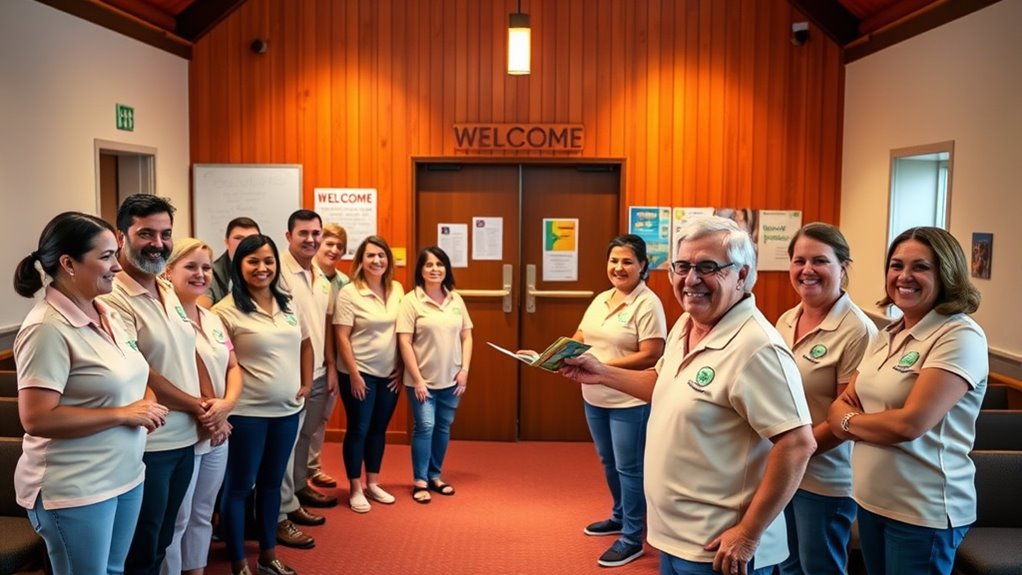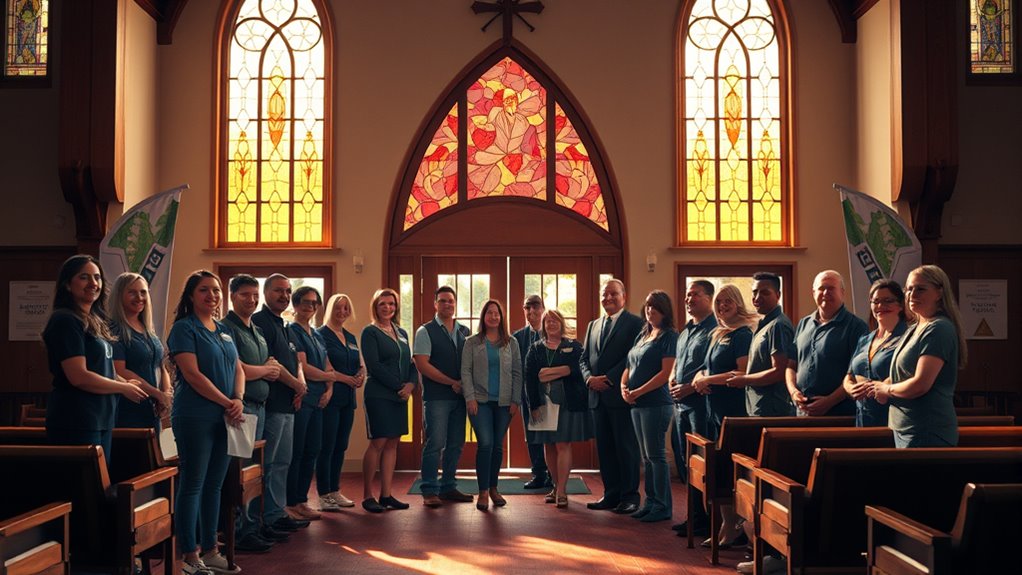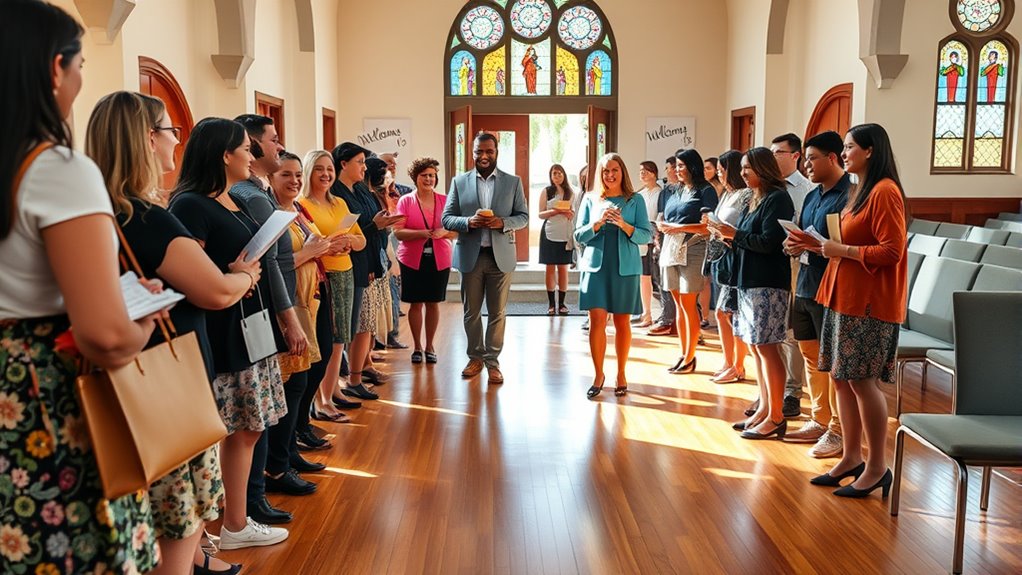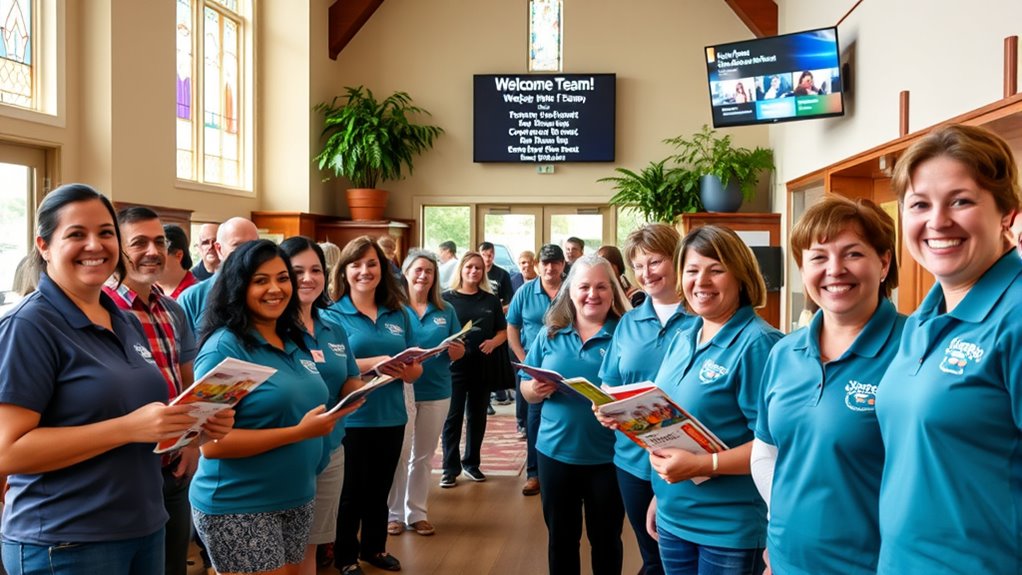To create a welcoming church team, start by recruiting friendly volunteers and providing ongoing training in hospitality and engagement. Focus on creating an inviting environment with warm greetings, genuine smiles, clear signage, and comfortable spaces. Encourage your team to connect with visitors, gather feedback, and celebrate milestones to build a community spirit. By implementing these best practices, you’ll strengthen your welcome experience—keep exploring to discover even more ways to make visitors feel truly at home.
Key Takeaways
- Create a warm, inviting atmosphere through friendly greetings, genuine warmth, and a welcoming environment with clear signage.
- Regularly train and equip team members with scripts, best practices, and role-playing to enhance hospitality skills.
- Use strategic signage and space organization to guide visitors smoothly and reduce confusion.
- Gather feedback via surveys, comments, and informal conversations to continually improve the welcome experience.
- Recognize volunteer efforts, track visitor engagement, and update procedures regularly to foster a positive community culture.
Recruiting and Training Friendly Volunteers

Recruiting and training friendly volunteers is essential for creating a warm and welcoming church environment. To attract the right people, you should leverage social media outreach, sharing posts that highlight volunteer opportunities and the positive impact they make. When recruiting, emphasize volunteer appreciation to show how their efforts are valued and recognized. Offer clear training that equips volunteers with the skills they need to greet visitors confidently and answer questions warmly. Recognize their contributions regularly, whether through shout-outs or small tokens of appreciation, to boost morale and retention. Engaging your congregation through social media also encourages members to volunteer and feel part of the team. Well-trained, appreciated volunteers will naturally create a friendly atmosphere that invites others to join and feel at home.
Creating a Warm and Inviting Environment

Once you’ve assembled your friendly volunteers and provided thorough training, the next step is to foster an environment that feels truly welcoming. Start with music selection—choose uplifting, familiar songs that set a positive tone and encourage a sense of community. Good parking management is also essential; guarantee clear signage, ample space, and friendly guidance to prevent stress and make arriving effortless. Greet visitors with genuine warmth and smile often. Keep the environment clean, well-lit, and inviting, with welcoming signage guiding guests smoothly. Small touches like comfortable seating areas or a friendly host at the entrance can considerably enhance comfort. By paying attention to these details, you create an atmosphere where visitors feel valued, relaxed, and enthusiastic to engage.
Developing Effective Greeting and Engagement Strategies

To create meaningful connections, focus on building genuine relationships with visitors from the moment they arrive. A warm smile and consistent eye contact can make guests feel truly welcomed and valued. By intentionally engaging with sincerity, you set the tone for a positive church experience.
Building Genuine Connections
Building genuine connections begins with creating a welcoming atmosphere where visitors feel seen and valued from the moment they arrive. To do this, incorporate tech integration, like digital check-ins or interactive displays, to streamline their experience. Be mindful of cultural sensitivity by respecting diverse backgrounds and traditions, making everyone feel comfortable. Use the following strategies:
| Strategy | Example | Benefit |
|---|---|---|
| Personal greetings | Use their name when welcoming | Builds trust and familiarity |
| Active listening | Show genuine interest in their story | Creates meaningful engagement |
| Cultural awareness | Respect customs and language preferences | Fosters inclusivity |
These approaches help turn a simple greeting into a heartfelt connection that encourages ongoing engagement.
Smiling and Eye Contact
Smiling and maintaining eye contact are powerful tools for creating a welcoming atmosphere. They demonstrate faithful hospitality and show you genuinely care about visitors. When you greet someone with a warm smile, you immediately put them at ease and signal openness. Coupling this with eye contact helps build trust and connection, making guests feel seen and valued. Your welcoming gestures, like a friendly nod or a reassuring glance, reinforce your sincerity. Remember, a sincere smile combined with steady eye contact can transform a simple greeting into a meaningful interaction. These small acts foster a sense of belonging, encouraging newcomers to stay and feel at home. Consistently practicing smiling and eye contact strengthens your ability to create an inviting environment rooted in genuine warmth.
Providing Clear Signage and Directions

You want visitors to find their way easily, so make sure signage is placed where it’s most visible. Clear directional arrows guide newcomers smoothly from parking to the main sanctuary. Well-designed signs help create a welcoming atmosphere from the moment they arrive.
Subheading 1: Visible Signage Placement
Clear signage is essential for guiding newcomers and ensuring a smooth, welcoming experience. Proper placement helps visitors navigate parking lot organization quickly, reducing confusion and stress. Place signs near entrances to direct guests to parking areas and clearly mark accessible spots. Use visible signs to indicate the location of the welcome team, restrooms, and sanctuary entrances. When considering music selection, ensure signage complements the atmosphere—friendly and inviting without overwhelming the senses. Position signs at eye level and in well-lit areas to maximize visibility. Consistent signage style and clear fonts make information easy to read from a distance. Effective signage placement minimizes bottlenecks, helps guests find their way effortlessly, and sets a positive tone from the moment they arrive.
Subheading 2: Clear Directional Arrows
Providing clear directional arrows is essential for guiding guests seamlessly through your church campus. Well-designed signage and arrows help visitors navigate your space organization effortlessly, reducing confusion and stress. Use bold, visible arrows that stand out against your signage design, ensuring they catch the eye from a distance. Place these arrows strategically at key junctions and decision points to direct guests confidently toward entrances, restrooms, children’s areas, and parking. Keep the signage consistent in style, color, and messaging to avoid ambiguity. Clear directional arrows streamline the visitor experience, making everyone feel welcomed and cared for from the moment they arrive. Proper space organization combined with effective signage design ensures your congregation’s hospitality shines through every detail.
Gathering and Utilizing Visitor Feedback

Gathering visitor feedback is essential for understanding how your church welcome team is making newcomers feel at home. It helps you identify strengths and areas for improvement through effective feedback collection and visitor insights. To maximize this process:
Gather visitor feedback to enhance your church’s welcoming experience and foster a more inviting community.
- Distribute simple surveys or comment cards after services to gather honest impressions.
- Use digital tools like online forms or follow-up emails to reach more visitors.
- Hold brief interviews or informal conversations to gain deeper insights.
- Regularly review feedback to spot patterns and adjust your welcoming strategies accordingly.
Continual Training and Team Development

Ongoing training and team development are essential to maintaining a welcoming environment that genuinely makes visitors feel valued. Regularly updating your team’s skills guarantees they stay confident, approachable, and prepared for community outreach efforts. Incorporate opportunities for volunteer recognition to motivate your team and reinforce their importance. Recognizing volunteers’ contributions encourages a culture of appreciation and continuous growth. Offer workshops, role-playing scenarios, and feedback sessions to sharpen hospitality skills and deepen understanding of visitor needs. When team members feel supported and valued, they’re more likely to create positive interactions that leave lasting impressions. Continual development not only improves individual performance but also strengthens the overall welcoming atmosphere, making your church a true community hub where everyone feels at home.
Frequently Asked Questions
How Can We Retain Volunteers Long-Term?
To retain volunteers long-term, focus on volunteer recognition and engaging training programs. Show appreciation regularly through heartfelt thank-yous and small tokens of gratitude. Invest in extensive training programs that empower volunteers with skills and confidence, making them feel valued and supported. When volunteers see their contributions appreciated and their growth prioritized, they’re more likely to stay committed and enthusiastic about serving your church community.
What Are Common Visitor Objections to Engaging?
Think of visitor concerns as clouds blocking the sun—common engagement barriers that can keep newcomers from connecting. You’ll often hear concerns about feeling out of place, unsure of what to do, or not knowing anyone. Address these visitor concerns with warmth and clarity, making it easy for them to engage. When you understand and ease these barriers, you create a welcoming atmosphere where visitors feel safe to take the first step.
How Do We Handle Difficult or Upset Visitors?
When handling difficult or upset visitors, you should prioritize visitor empathy and conflict resolution. Listen carefully to their concerns without interrupting, acknowledge their feelings, and remain calm. Use empathetic language to show you understand their frustration. Offer solutions or direct them to someone who can help. Your calm, caring approach helps de-escalate situations and shows that their experience matters, fostering a welcoming environment for everyone.
What Metrics Best Measure Welcoming Effectiveness?
Ever wondered how to truly gauge your welcoming impact? Metrics like visitor feedback, repeat attendance, and volunteer observations reveal the truth. Focus on greeting strategies and volunteer training, because they’re your secret weapons. Track how visitors respond, and adjust your approach accordingly. By measuring these indicators, you’ll uncover the real effectiveness of your welcome team, turning good intentions into meaningful connections that keep newcomers coming back.
How Can Technology Enhance the Welcome Experience?
Technology can markedly enhance your welcome experience by making guests feel more comfortable and engaged. Use interactive signage to provide directions, event info, and encouragement, creating a welcoming atmosphere. Implement mobile check-in to streamline arrivals, reduce wait times, and show you value their time. These tools help you connect more personally, facilitate smooth transitions, and foster a friendly environment right from the start.
Conclusion
So, after all this talk about warm welcomes and friendly faces, you might think your church’s welcome team has it all figured out. But remember, no matter how many signs or training sessions you have, the real magic happens when your team genuinely cares. Ironically, the smallest sincere gesture often makes the biggest difference. Keep improving, stay genuine, and watch how those tiny acts of kindness become the most inviting part of your church.










